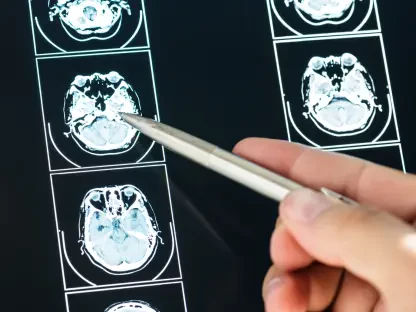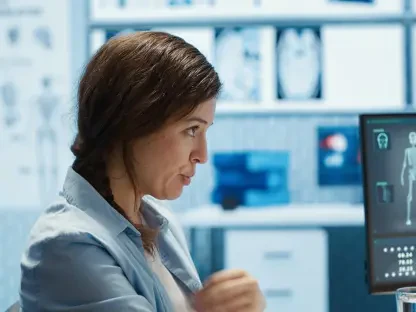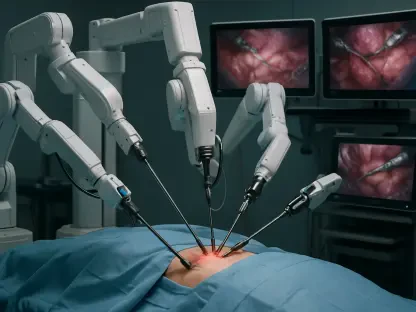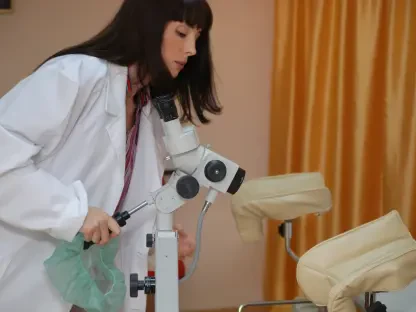Significant shifts in the funding landscape of the U.S. National Institutes of Health (NIH) demand attention, particularly within the field of radiology research. Under President Donald Trump’s fiscal year 2026 budget proposal, profound changes aim to redirect research priorities. The budget calls for an $18 billion reduction in health research spending, sparking apprehension in the radiology research community. The proposed realignment focuses predominantly on chronic disease research, which stands to dramatically reshape how funding is allocated, raising widespread concern about the future of the discipline.
Realignment of Funding Priorities
Political Motivation Behind Budget Proposal
The proposed shift of NIH funding priorities to focus on chronic disease research reveals a significant redirection of financial resources. Areas like climate change and gender ideology are notably excluded from the proposed research agenda. This exclusion suggests possible political motivations underpinning the budget, which could profoundly alter the traditionally comprehensive support NIH has extended across various research fields. These changes have sparked debates over whether political agendas are influencing scientific funding without adequately considering the broader impacts on innovation and discovery.
The perception of such political motivation has generated concern among researchers who relied on previously supported research areas. The realignment not only affects funding decisions but also has a broader impact on the landscape of scientific inquiry. Researchers express worry that the exclusion of certain research areas could lead to overlooked scientific questions that might yield significant benefits to society. Beyond just research focus, this budgetary reorientation also raises critical questions about the influence of politics on scientific progress and the potential barriers this creates to independent scientific exploration.
Immediate Termination of Grants
The budget reform resulted in an immediate and widely felt shock due to the termination of NIH grants amounting to nearly $1.9 billion. The financial ripple greatly affected various institutions, including medical schools and hospitals, which saw grant concessions totaling just over $1 billion. This abrupt termination of financial support profoundly impacted not only ongoing projects but also future research aspirations across numerous disciplines. New York, North Carolina, California, Texas, and Florida emerged as the states most acutely affected by these cuts, exacerbating concerns about geographic disparities in research support.
The sudden cessation of grants left institutions scrambling for alternatives, as many projects that relied on continued financial backing were suddenly jeopardized. Researchers reliant on these funds faced immediate challenges, including reallocation of resources and reconsideration of project viability. The necessity for abrupt adjustments to research plans has placed additional stress on institutions striving to maintain the integrity of scientific exploration amidst such funding uncertainty. This swift financial disruption highlights the precarious nature of dependency on federal funding and underscores the importance of diversified financial strategies for academic research stability.
Nature and Impact of Affected Grants
Analysis of Terminated Grant Types
An analysis by the Association of American Medical Colleges (AAMC) revealed that specific types of grants, notably R01, F31, and UM1 grants, were heavily impacted by the budget cuts. These grants play pivotal roles in the sustainability of independent research, graduate training, and large-scale investigative endeavors. R01 grants, essential for supporting individual research endeavors, expect distinct impacts due to the terminations that compromise the pursuit of innovative inquiries. F31 grants, crucial for graduate student advancement, see disruptions that could hinder the development of the next generation of researchers.
The reduction in UM1 grant funding presents significant challenges to large-scale, multidisciplinary projects that rely on extensive collaboration and resources. The disruption associated with these grant types not only affects individual research projects but also poses a broader threat to the continuity of scientific advancement. The cessation of funding for such essential research endeavors places strains on institution-wide strategies that depend on collaborative scientific efforts. The suspension of these grant types exemplifies the widespread financial disturbance occurring within the radiology research community due to the budgetary adjustments.
Multidisciplinary Project Challenges
The termination of grants integral to multidisciplinary projects has created significant obstacles to cross-disciplinary academic endeavors. These challenges are particularly pronounced in fields like radiology research, where collaboration across various scientific domains is crucial for innovation and progress. The funding disruptions threaten the cohesion of research teams and deter the continuation of projects that demand coherent collective efforts to tackle complex scientific questions. The abrupt stop to funding poses a direct risk to the momentum of these collaborative initiatives, placing their progress and viability in jeopardy.
The impact on multidisciplinary research extends beyond immediate financial concerns. It potentially stifles the innovative potential generated from diverse scientific interactions and shared expertise. Multidisciplinary projects, known for their contributions to extensive and integrative scientific discovery, now face significant operational hurdles. Strategies for maintaining these partnerships are required to navigate the challenges of funding shortages, ensuring that the collaborative nature of scientific progress is preserved. Adapting to these difficulties is essential for maintaining the momentum and impact of multidisciplinary research within the radiology field and beyond.
Institutional Reactions and Strategies
Diverse Institutional Responses
Facing funding cuts, institutions exhibit varied responses to manage the ensuing challenges. Some institutions have prioritized advocacy efforts and mobilizing research communities to counteract the negative effects of these financial changes. Direct engagement with congressional representatives emerges as a strategy to address concerns about the impacts on research endeavors. Other institutions lean heavily on social media campaigns to rally public support and emphasize the need for sustained investment in scientific research. These varied responses underscore the importance of adaptability in navigating the funding reductions.
An effective approach involves personalized letters to Congress that highlight individual stories and concerns, aiming to humanize and underscore the broader impact of funding cuts. Institutions modify their strategies to effectively address these challenges, recognizing the need for comprehensive, multifaceted approaches. Such strategies are crucial in mitigating the financial shocks felt by the research community and in ensuring that voices are brought to the various ways these budget changes affect scientific progress. The diversity in approaches also demonstrates institutions’ resilience and commitment to maintaining and advancing research endeavors amidst these tumultuous changes.
Advocacy and Campaigns
Leaders in the research community are actively advocating for congressional backing by emphasizing the adverse effects of funding instability on research morale and innovation. Additionally, there is apprehension that persistent funding volatility may deter young investigators from pursuing careers in research fields like radiology. Emphasizing the integral role of continuous investment can ensure the health and progression of scientific research. Campaigns that promote increased awareness about funding reductions and their ramifications are necessary for galvanizing support—not only from lawmakers but also from broader society about the importance of sustained research funding.
Instituting these advocacy efforts proves vital in combating potential declines in new researcher interest triggered by fears of uncertain funding landscapes. Ensuring steady engagement with congressional bodies is integral for maintaining ongoing dialogue regarding the impacts of budget cuts on scientific advancement. Institutions must coordinate efforts to communicate these messages during times of fiscal reform and uncertainty, drawing attention to the necessity of stable funding to secure ongoing research innovation. Advocacy and community engagement remain key elements in shaping future policy decisions that benefit the research community at large.
Long-term Concerns and Strategic Adjustments
Pessimism and Potential Talent Drain
A prevailing sense of pessimism pervades the research community amidst concerns that funding instability may lead to a significant talent drain. Young scientific minds often reevaluate research career prospects when faced with uncertainty in funding landscapes—a situation that poses considerable risks to fields like radiology that rely on the influx of innovative thinkers. Academic institutions must consider strategic methods to bolster morale and assure potential new researchers of viable career paths amid fiscal challenges. Addressing these concerns is central to retaining and attracting scientific talent crucial for ongoing innovation.
Institutions may need to rethink hiring practices and offer additional incentives to retain young researchers. These strategies could protect the vibrancy and continuity of research, allowing institutions to maintain momentum despite fiscal instability. Overcoming these barriers requires concerted effort and creative solutions to ensure that potential talent does not bypass scientific careers due to fears of inconsistencies in funding and support. Connecting potential researchers to broader scientific networks and mentorship opportunities may provide assurance and alleviate concerns that emerge due to budgetary turbulence and political uncertainty.
Strategies for Securing Funding
Cognizant of the potential roadblocks, radiology researchers are advised to chart diversified funding landscapes beyond NIH’s reach. Seeking grants from institutes like the Patient-Centered Outcomes Research Institute (PCORI) becomes strategic for ensuring research pursuits maintain financial backing despite political shifts. Emphasizing language and areas within submissions that avoid politically sensitive subjects can serve as another tactic to navigate the changing funding expectations. The exploration of varied funding avenues offers a practical way for researchers to offset potential drops in NIH allocations.
Diversifying funding sources appears paramount for securing the future sustainability of radiology research initiatives. Institutions need to deploy grant-writing strategies that consider political climates and areas currently prioritized for research funding. Engaging with a range of potential donors and funding bodies can provide a lifeline for research endeavors facing potential budget constraints. Exploring these funding strategies remains essential for enhancing institution-wide resilience during fiscal downturns, ensuring research continuity even amid broader political changes and financial reductions.
Impact on Broader Research Agencies
Threats to Healthcare Research Agencies
The impacts of budget reductions reverberate across healthcare research agencies, including the Centers for Disease Control and Prevention (CDC) and the Food and Drug Administration (FDA). Like NIH, these agencies face threats that potentially undermine their scientific duties and capacity to uphold expansive research mandates. The potential repercussions are widespread, generating notable uncertainties regarding the sustained continuation of integral scientific efforts at these institutions. The financial restraints potentially affect these agencies’ abilities to advance public health efforts and produce critical scientific insights.
The looming threats necessitate strategic responses among healthcare research entities seeking to manage and mitigate the repercussions emerging from budget cuts. Proactive adaptation is vital, allowing agencies to maintain momentum and adaptability in advancing their scientific initiatives and meeting public health goals. As these entities navigate budget constraints, a concerted effort is required to uphold commitment to primary scientific objectives. Leveraging available resources and seeking collaborative partnerships are essential for continuing contributions to societal health in the future.
Advocacy for Imaging and Radiology Research
The radiology research sector has mounted concerted advocacy efforts to assert the critical nature of imaging in tackling chronic disease, positioning it as an indispensable asset within the healthcare and research landscape. This community emphasizes that policy shifts to prioritize chronic disease investigations should not come at the expense of other areas, including imaging, as they play vital roles in patient care and influencing healthcare outcomes. Engaging with decision-makers and the legislative process ensures ample representation of imaging research within the broader health funding paradigm amid fluctuating fiscal policies.
Radiology researchers continue to advocate for imaging’s valued place in scientific inquiry and its direct application within clinical settings through various platforms. They employ lobbying efforts drawing attention to the indispensable contributions made within their field. Stressing imaging’s relevance, especially within chronic disease management, highlights this discipline’s influence on informing patient care. This emphasis on its unwavering importance not only validates current research efforts but also positions imaging as integral to future investments and healthcare advancements.
Coping Mechanisms and Institutional Strategies
Engagement with Congress and Legislators
Facing myriad challenges posed by the funding instability, radiology research institutions have proactively engaged both legislative bodies and broader audiences, seeking additional support and funding stability. Direct communications and personal narratives are leveraged to convey various concerns, urging legislative representatives to consider strategic improvements to secure sufficient research funding. Institutions acknowledge that consistent advocacy plays a vital role in maintaining visibility within continuous discussions about financial policy.
Engagement with lawmakers is complemented by a combination of strategic alliances and community outreach efforts, affirming the broader significance of stable healthcare research funding. Collectively, research bodies engage in a unified dialogue with legislators, aiming to sustain critical imaging initiatives that contribute significantly to patient outcomes and scientific progression. The engagement strategies enable researchers to convey shared messages and engage broader communities, cultivating mutual support for enhanced research funding. This collective determination to secure scientific and fiscal sustainability remains a central priority.
Diversification of Funding Sources
Diversification of funding sources is a strategic necessity for radiology research institutions faced with ongoing financial challenges. The potential threat of diminishing NIH support spurs researchers to seek alternative funding from various institutions and organizations like PCORI. By diversifying financial resources, research endeavors stand resilient against fiscal fluctuations, ensuring that scientific inquiry remains unhindered. This practice offers a safety net, reducing reliance on singular funding bodies prone to budgetary restraints driven by political considerations.
Radiology research institutions are expanding their networks to pique donor interest from non-federal sources, securing investments for future projects. This proactive approach reduces reliance on any singular budget stream, providing a broader platform for resource acquisition. Continued engagement and partnerships with varied funding bodies further solidify long-term equilibrium. Institutions committed to advancing research aim to adapt swiftly to fiscal challenges to sustain trajectory and uphold scientific progress. With a diversified funding base, institutions are better positioned to uphold their research agendas, even amidst regulatory shifts.
Sustaining Scientific Inquiry Amidst Change
The ever-evolving landscape of funding for the U.S. National Institutes of Health (NIH) requires close examination, especially in the radiology research sector. President Donald Trump’s fiscal year 2026 budget proposal has ushered in notable reforms aimed at reshaping research strategies. This budget suggests slashing health research spending by $18 billion, which has stirred unease within the radiology research community. The proposed budget prioritizes chronic disease research, signaling a substantial shift in funding allocation patterns. These changes are expected to have a profound impact on the future of radiology research.
Radiology professionals and researchers are expressing significant concern regarding the reallocation of funds, fearing that their field may not receive the necessary support to advance technological and diagnostic innovations. The redistribution of resources to chronic disease research raises questions about the viability and ongoing development of radiological advancements. As radiology research plays a crucial role in diagnosing and managing various medical conditions, its future under the new budget constraints remains uncertain. The broader implications of these funding changes may influence how health research priorities are established, potentially affecting innovations that could shape healthcare delivery for years to come.









